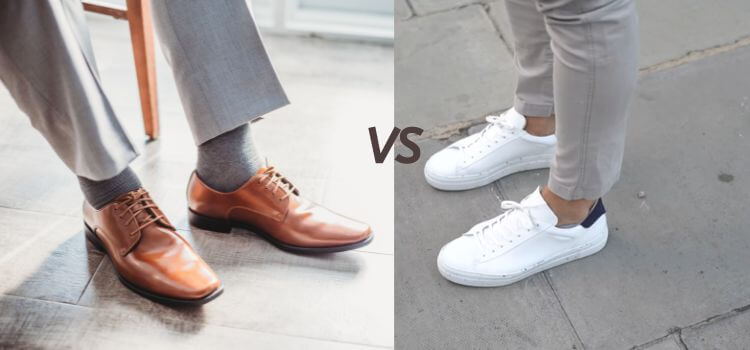As an Amazon Associate I earn from qualifying purchases.

When it comes to footwear, choosing the right fit is crucial for both comfort and long-term foot health. Sneaker fit vs. dress shoe fit is an important comparison, as each type of shoe is designed with different purposes and styles in mind. Understanding the nuances between these two types of footwear can make all the difference in how you look and feel.
In this article, we’ll break down the key differences between sneaker and dress shoe fit, covering everything from sizing, materials, and support, to how each type of shoe molds to your feet over time. Whether you’re dressing up for a formal event or heading out for a casual day, the right fit can ensure you step out in comfort and style.
Why Footwear Fit Matters for Both Sneakers and Dress Shoes
An ill-fitting shoe can cause various problems, including blisters, foot pain, posture issues, and even long-term health issues like bunions and plantar fasciitis. Whether heading to a formal event or hitting the gym, getting the right fit can make all the difference.
In this article, we’ll explore the essential differences between sneaker fit and dress shoe fit, covering key aspects like sizing, materials, support, and break-in time, to ensure your feet are always comfortable and stylish.
How Sizing Differs Between Sneakers and Dress Shoes
Sneakers: Room for Comfort and Movement
Sneakers are generally designed with a more relaxed, casual fit in mind. They often feature roomy toe boxes and materials like mesh or synthetic fabrics that allow for flexibility and movement. Most people find that their sneaker size remains consistent across brands, though slight variations in sizing may occur due to different shoe technologies or designs.
Dress Shoes: A Snug, Tailored Fit
Dress shoes, on the other hand, are typically designed for a snug fit, with less room for error. They are crafted from rigid materials like leather, which offers less give than sneaker materials. As a result, many people find that they need to size up in dress shoes to achieve a comfortable fit. The tighter fit ensures a sleek, polished appearance but can be less forgiving when it comes to comfort.
Key Material Differences and Their Impact on Fit
The material a shoe is made from has a significant impact on how it fits and feels over time.
Sneaker Materials: Flexibility and Immediate Comfort
Most sneakers are made from flexible materials like canvas, mesh, or synthetic fabrics, making them more forgiving right out of the box. These materials are designed to stretch and mold to your foot over time, allowing for a comfortable fit even with minimal break-in time. This makes sneakers ideal for all-day wear and physical activity.
Dress Shoe Materials: Structure and Long-Term Fit
Dress shoes, however, are usually made from rigid materials such as leather or suede. While these materials offer durability and a refined appearance, they require a longer break-in period to mold to your foot. Leather dress shoes, in particular, can feel stiff at first, but over time, they form a custom fit that enhances both comfort and style.
Support and Cushioning: How Sneakers and Dress Shoes Differ
Sneakers: Built for Support and Movement
Sneakers are designed with high levels of cushioning and support, especially in the midsole and heel areas. Brands like Nike and Adidas incorporate various technologies—such as air cushioning and memory foam—to ensure maximum comfort, particularly during extended periods of walking or physical activity. For those with foot problems like flat feet or high arches, sneakers often come with built-in support to alleviate discomfort.
Dress Shoes: Minimal Cushioning, Maximum Elegance
Dress shoes, by contrast, offer far less cushioning. Their sleek design prioritizes appearance over comfort, with a firm sole that provides support but lacks the plush padding found in sneakers. This means they may not be suitable for long periods of standing or walking without discomfort. If you wear dress shoes regularly, consider adding custom insoles to enhance comfort and support.
Also read: Moccasins vs.Loafers
Break-In Period: How Each Type of Shoe Adapts to Your Feet
Sneakers: Ready to Wear Right Away
One of the advantages of sneakers is that they usually require little to no break-in time. Their flexible materials and cushioned soles make them comfortable from the moment you put them on. Over time, they may stretch slightly, but this typically results in an even better fit.
Dress Shoes: A Gradual Adjustment
Dress shoes, particularly leather ones, often require a lengthy break-in period. Initially, they may feel stiff and even uncomfortable, but as the leather softens, the shoes will start to mold to your feet, creating a more personalized fit. This process can take several weeks, so it’s essential to wear your dress shoes in short bursts at first to avoid blisters and discomfort.
Arch Support: A Critical Difference Between Sneakers and Dress Shoes
Footwear arch support is crucial for maintaining foot health and comfort, particularly for individuals with specific foot conditions.
Sneakers: Engineered for Support
Many sneakers are designed with advanced arch support systems, making them ideal for people with flat feet or high arches. The integrated support distributes weight evenly across the foot, relieving pressure on the arches and helping to prevent long-term foot issues.
Dress Shoes: Limited Arch Support
Most dress shoes, unfortunately, lack adequate arch support. While some high-end brands offer models with built-in support, the majority of dress shoes are designed with a flatter sole. For individuals requiring more arch support, investing in custom insoles is recommended.
Style and Fit: How Each Shoe’s Design Influences Comfort
Sneakers: Designed for Versatility
Sneakers are designed with comfort in mind, offering a variety of styles—from low-tops to high-tops—that cater to different foot shapes and sizes. The rounded toe box and flexible construction ensure that sneakers accommodate natural foot movement, making them a versatile choice for everyday wear.
Dress Shoes: Tailored for Elegance
Dress shoes, on the other hand, are designed for a tailored look. Styles like Oxfords, Derbies, and Loafers often feature a more structured and narrow fit, especially in pointed-toe designs. This makes finding the perfect size even more crucial, as a poorly fitting dress shoe can quickly lead to discomfort.
Also read: Hey Dude vs Skechers
Tips for Finding the Perfect Fit for Sneakers and Dress Shoes
Measure Your Feet Regularly
Your foot size can change over time due to factors like age or weight gain. Make sure to measure your feet before purchasing new shoes, especially if you’re buying a different type (sneakers vs. dress shoes).
Shop Later in the Day
Feet often swell as the day progresses, so it’s best to try on shoes in the afternoon or evening to ensure comfort for prolonged wear.
Wear the Right Socks
The kind of socks you wear can influence how your shoes fit. Make sure to wear athletic socks when trying on sneakers and thin dress socks when trying on dress shoes to get an accurate fit.
Conclusion: Choosing the Right Shoe Fit for Comfort and Style
In the battle of sneaker fit vs. dress shoe fit, understanding the nuances of each type of shoe will help you make the best choice for any occasion. Sneakers offer unparalleled comfort and flexibility, making them perfect for casual or athletic wear. Dress shoes, while less forgiving, provide a sophisticated and sleek look that’s essential for formal events. By following the tips outlined in this guide, you’ll be able to find the perfect fit for both sneakers and dress shoes, ensuring comfort and style with every step.
Amazon and the Amazon logo are trademarks of Amazon.com, Inc, or its affiliates.




Leave a Reply